Recent News & Events
Dolly the Cloned Sheep and the Cell Reprogramming Technique that Created Her 20 Years Ago!
12
 Did you know that it's been 20 years since the birth of Dolly the cloned sheep? Dolly's story made headlines worldwide and stirred some very passionate (heated) debates as it entered the history books, forever altering the future of life as we had known it prior to that. Whether you remember Dolly the cloned sheep or not, read on to find out why she was so important, what happened to her and how the cell reprogramming techniques that created Dolly have led to life changing advancements. All of which were made possible by the groundbreaking research that created Dolly.
Did you know that it's been 20 years since the birth of Dolly the cloned sheep? Dolly's story made headlines worldwide and stirred some very passionate (heated) debates as it entered the history books, forever altering the future of life as we had known it prior to that. Whether you remember Dolly the cloned sheep or not, read on to find out why she was so important, what happened to her and how the cell reprogramming techniques that created Dolly have led to life changing advancements. All of which were made possible by the groundbreaking research that created Dolly.
So Who Was Dolly?
Dolly is the most famous clone that the world has ever known. She was the first mammal to be cloned from adult cells and the first and greatest achievement in cell reprogramming and cloning fields to date. Dolly started her life in a test tube and was later transferred into a surrogate mother. After 148 days of pregnancy, Dolly was officially born on 5th July 1996 weighing 6.6kg. She was jointly cloned by researchers at the University of Edinburgh and PPL therapeutics, a company also based in Edinburgh. Her original code name was ‘6LLS’, but she was later renamed ‘Dolly’ after Dolly Parton.
To quote one of the researchers, Sir Ian Wilmut, "Dolly was derived from a mammary gland cell and we couldn't think of a more impressive pair of glands than Dolly Parton's"
How Was Dolly Created?
Dolly was created from a reprogrammed udder cell that was removed from a 6-year-old Finn Dorset sheep. The udder cell was placed in a growth medium to keep the cells alive and growing. They then placed the cell into a de-nucleated ovum by a process known as somatic cell nuclear transfer. The cell was stimulated by an electric shock to cause it to divide and then implanted into the surrogate mother. From there nature had to take course. From the collection of cells that were being processed, Dolly was the only one that went to a full term pregnancy. In total, there were 277 cell fusions from which twenty nine early embryos developed that were then implanted into thirteen surrogate mothers.
However, the telomeres in Dolly’s chromosomes were found to be shorter than that of other sheep of the same age. Telomeres are the sections at either end of chromosomes that get shorter after they divide. Her early aging has been a cause for debate but since her cells had been proliferated from a 6-year-old sheep, the telomeres where shorter than sheep that are born by a natural pregnancy, so this is considered by many to be a contributing factor. Dolly did inherit mitochondria from the egg donor mother so she was not identical to her genetic mother though.
What Happened to Dolly?
Dolly led a normal life at the Roslin Institute in Edinburgh. She was allowed to breed in the same manner as sheep born by natural means and over her lifetime she produced six healthy offspring in total. This was also a major milestone surrounding Dolly, as it showed that a cloned animal could reproduce naturally.
Dolly unfortunately contracted arthritis in 2001, but that was not what took Dolly from the world. Dolly, like many other cloned sheep, contracted sheep pulmonary adenomatosis (SPA) which is an incurable disease that ultimately took her life. She passed away on February 14th, 2003 at the age of six and the decision was made to let her go naturally so no attempts were made to try and resuscitate her. The average life expectancy of sheep is 8 to 12 years.
Since Dolly, more sheep, as well as many other animals have been cloned. One of the most remarkable occurred in 2004 when a mouse was cloned from an olfactory neuron, a cell that doesn’t normally divide. Advancements have also led to therapies that can treat mitochondrial diseases such as muscular dystrophy. Most of the advancements that are made in this field, if not all, can all be traced back to the momentous research that gave us Dolly.
